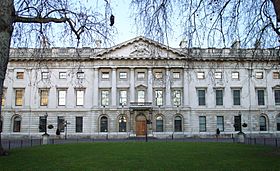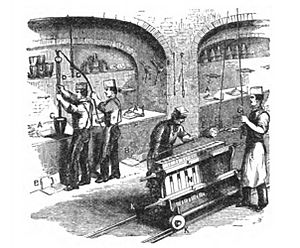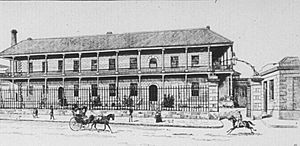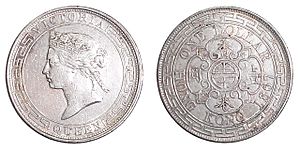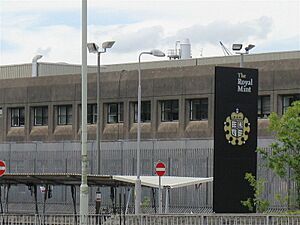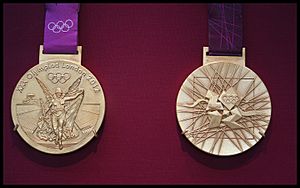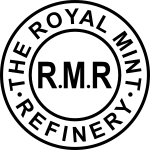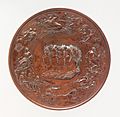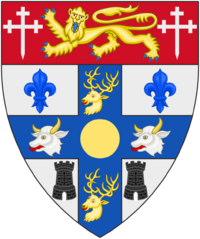Royal Mint facts for kids
 |
|
|
Trade name
|
The Royal Mint |
|---|---|
| State-owned limited company | |
| Industry | Coin and medal production |
| Founded | c. 886 (origins) 1279 (unified system) 16 July 2009 (current legal structure) |
| Headquarters | Llantrisant, Rhondda Cynon Taf, Wales |
|
Area served
|
United Kingdom and British Overseas Territories |
|
Key people
|
Anne Jessopp (Chief Executive) |
| Products | Coins Medals Bullion |
| Revenue | £1.3 billion (2024) |
|
Operating income
|
–£1.9 million (2024) |
| –£4.1 million (2024) | |
| Total assets | £73.7 million (2024) |
| Total equity | £73.7 million (2024) |
| Owner | HM Treasury |
|
Number of employees
|
899 (2024) |
The Royal Mint is the official maker of British coins for the United Kingdom. It is located in Llantrisant, Wales, where it moved in 1968.
The Royal Mint Limited is a company fully owned by His Majesty's Treasury. It has a special agreement to make all of the nation's coins. Besides making coins for the UK and other countries, the Royal Mint also sells valuable metal products.
Historically, the Royal Mint was one of many mints that eventually joined together. They produced coins for the Kingdom of England, then for all of Great Britain, the United Kingdom, and many nations in the Commonwealth.
For hundreds of years, the Royal Mint operated inside the Tower of London. Later, it moved to a place now called Royal Mint Court. In the 1960s, Britain changed its money system to decimal currency. This meant the Mint needed a much bigger place. So, it moved from London to a new 38-acre plant in Llantrisant, Wales, where it has been ever since.
Since 2018, the Royal Mint has been changing its business. This is because people are using less cash. It has started focusing on investing in precious metals, selling old coins, and creating luxury collectibles. These changes helped it make a profit of £12.7 million in 2020–2021.
In 2022, the Royal Mint announced it was building a new factory in South Wales. This factory recovers valuable metals from electronic waste. The first gold recovered this way is now used in a new jewellery line. This line is called 886 by The Royal Mint, celebrating its symbolic founding date of 886 AD.
Contents
- The Royal Mint's Journey Through Time
- How the Royal Mint Works
- Images for kids
- The Trial of the Pyx
- Arms
- See also
The Royal Mint's Journey Through Time
How Coins Began in Britain
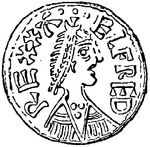
The story of coins in Great Britain started around 200 BC. Celtic tribes from across the English Channel first brought them. The earliest record of coins being made in Britain is from Kentish tribes around 80–60 BC. They copied coins from Marseille by casting them, not by hammering.
After the Romans invaded Britain in 43 AD, they set up mints. These mints made Roman coins for about 40 years before closing. A mint in London briefly reopened in 383 AD but closed quickly as Roman rule ended. For the next 200 years, it seems no coins were made in Britain. Then, in the sixth and seventh centuries, English kingdoms began to appear. By 650 AD, there were as many as 30 mints across Britain.
From Many Mints to One: 1279 to 1672
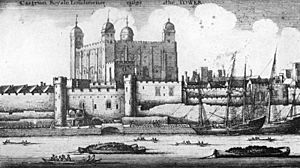
In 1279, the many mints in the country were brought together. Control was given to the mint inside the Tower of London. Most mints outside London closed, with only a few local ones continuing. Records from the London mint show money spent on workshops and timber.
By 1464, specific jobs at the mint were well-defined. The master worker hired engravers and managed moneyers. The Warden made sure that dies (tools for stamping coins) were delivered. In 1472, a special mint board was created. It gave the mint's main jobs to three people: a warden, a master, and a comptroller.
In the early 1500s, Europe was growing economically, but England faced money problems. This was due to too much government spending. By the 1540s, wars with France and Scotland led Henry VIII to start "The Great Debasement." This meant he greatly reduced the amount of valuable metal in coins. To control the country's money better, monasteries were closed. This stopped most coin production outside London.
In 1603, England and Scotland united under King James I. This led to a partial joining of their currencies. Scotland's silver coins had much less silver, so they were worth less. To make up the difference, unofficial token coins, often made of lead, were made by unauthorized people. By 1612, there were 3,000 such unlicensed mints. The Royal Mint, busy with more profitable gold and silver coins, hired Lord Harington. He started making copper farthings in 1613. Private licenses to make these coins were stopped in 1644. This led traders to make their own tokens again. Finally, in 1672, the Royal Mint took over making all copper coins.
Mints During the Civil War
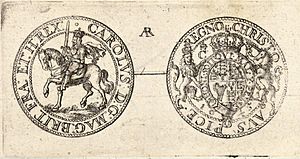
Before the English Civil War began, England signed a treaty with Spain in 1630. This ensured a steady supply of silver to the Tower mint. Extra mints were set up to help the London one, including one at Aberystwyth Castle in Wales. In 1642, parliament took control of the Tower mint. After Charles I tried to arrest some members of parliament, he had to leave London. He then set up at least 16 emergency mints across the British Isles. These were in places like Carlisle, Chester, Exeter, and York.
After the war started, Charles asked Thomas Bushell, who owned a mint and silver mine, to move his operations. Bushell moved his mint to Shrewsbury, then to Charles's headquarters in Oxford. The Oxford mint started on December 15, 1642. There, silver plates and foreign coins were melted down or quickly hammered into new coins. Bushell was in charge of this mint. When Prince Rupert took control of Oxford, Bushell moved to Bristol Castle. He continued making coins there until 1645, when Parliament took over.
In November 1642, the king ordered Richard Vyvyan to build mints in Cornwall. Vyvyan built a mint in Truro. In December 1642, Parliament set up a mint in nearby Exeter. When royalist troops captured Exeter in 1643, Vyvyan moved his Truro mint there.
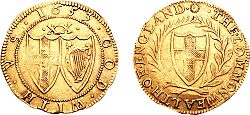
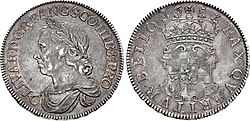
After Charles I was executed in 1649, the new Commonwealth of England made its own coins. For the first time, these coins used English instead of Latin. They also had simpler designs. The government invited French engineer Peter Blondeau from the Paris Mint to London in 1649. They hoped he could modernize coin making. In France, hammer-struck coins had been replaced by milled coinage (made by machines). Blondeau started testing in 1651, making milled silver coins. However, other money makers still used the old hammering method.
In 1656, Lord Protector Oliver Cromwell ordered an engraver, Thomas Simon, to create dies with his image. These were to be minted using the new milled method. Few of Cromwell's coins were used by the public. Cromwell died in 1658, and the Commonwealth ended two years later. Without Cromwell's support for milled coins, Blondeau went back to France. England continued to make hammer-struck coins.
Modernizing Coin Production: 1660 to 1805

In 1662, Charles II brought Peter Blondeau back to England. This time, the goal was to permanently make coins using machines. Even with these new milled coins, counterfeiting (making fake coins) and clipping (shaving off metal from the edges) were still big problems. To fight this, the phrase Decus et tutamen ("An ornament and a safeguard") was added to the edges of some coins.
After the Glorious Revolution of 1688, when James II lost power, parliament took control of the mint. Before this, the mint had been an independent body, making coins for the King.
Under the support of Charles Montagu, 1st Earl of Halifax, Isaac Newton became the mint's warden in 1696. Newton took his job very seriously, even though it was meant to be an easy position. He worked hard to fight the growing problem of fake coins. At this time, 10% of the country's coins were fake, and clipping was common. The silver in coins was worth more than their face value. King William III started the Great Recoinage of 1696. All old coins were removed from circulation. The Coin Act 1696 made it high treason (a very serious crime) to own equipment for making fake coins. New mints were set up in places like Bristol, Chester, and York to help with the recoinage. Old coins were valued by their weight, not their face value.
The Acts of Union 1707 joined England and Scotland into one country. London then took over making Scotland's money, replacing the Pound Scots with the English Pound sterling. As a result, the Edinburgh mint closed in 1710. As the British Empire grew, so did the need for more coins. This, along with the need for new machines and crowded conditions at the Tower of London, led to plans for the mint to move to nearby East Smithfield.
A New Home at Tower Hill: 1805 to 1914
Construction of the new mint on Tower Hill, across from the Tower of London, began in 1805 and finished in 1809. In 1812, the move became official. The main building was the Johnson Smirke Building, named after its designer James Johnson and builder Robert Smirke. This building had gatehouses on both sides, and behind them was another building with the mint's new machines. Other smaller buildings housed mint officers and staff. A wall protected the entire site, patrolled by the Royal Mint's guards.
By 1856, the mint was not working efficiently. There were problems with the purity and weight of the coins. The Prime Minister, Lord Palmerston, told the Master of the Mint, Thomas Graham, that the mint needed to improve or it would be managed by private companies. Graham asked chemist August Wilhelm von Hofmann for advice. Hofmann recommended his student George Frederick Ansell to fix the mint's problems. Ansell was hired in November 1856.
Ansell found that the weighing of metals was very inaccurate. Gold was weighed to the nearest 0.05 ounces, which led to losses. For example, Ansell delivered 7920 ounces of gold, but the mint weighed it as 7918.15 ounces. After a more accurate weighing, it was found to be 7919.98 ounces. To make weighing more precise, new equipment was ordered. Between 1856 and 1866, old scales were replaced with new, more accurate ones.
Ansell also noticed gold was lost during manufacturing. He found that 15 to 20 ounces could be recovered from the "sweep." This was the leftover burnt waste from the minting process. He realized the lost weight was due to oil, dust, and other foreign materials mixed with the gold.
In 1859, the Royal Mint rejected a batch of gold because it was too brittle for making gold sovereigns. Ansell, with his chemistry background, experimented with the metal. He successfully produced 167,539 gold sovereigns from it. In 1868, another £500,000 worth of gold coins were found to be of poor quality. Although rejected coins were usually melted down, many entered circulation. The mint had to return thousands of ounces of gold to the Bank of England. Ansell offered to re-melt the bad coins, but his offer was rejected. This led to an argument with senior mint officials, and Ansell was removed from his job.
Royal Mint Refinery
After moving to Tower Hill, the Mint faced more questions about how it handled unrefined gold. The Master of the Mint had been in charge of this since the 1300s. However, the refining process was too expensive and lacked clear responsibility. A Royal Commission in 1848 suggested that refining should be done by an outside company. Anthony de Rothschild, from the famous Rothschild family, took on this role. In 1852, he leased equipment and buildings next to the Royal Mint. He named his business Royal Mint Refinery.
Mints Around the World
As Britain's power grew and it established colonies, there was a greater need for coins overseas. This first happened in Colony of New South Wales, Australia. The 1851 Australian gold rush led to a black market in gold, threatening the colony's economy. In 1851, the colony asked Queen Victoria for a local mint in Sydney. In 1853, the Queen approved the establishment of the Sydney Branch of the Royal Mint. It opened in 1855. Production quickly increased, with the mint making over £1,000,000 worth of coins each year in its first five years. By 1868, gold sovereigns made in Sydney were accepted as money in all British colonies. In 1886, they were given equal status in the UK.
The success of the Sydney branch led to new branches opening in Melbourne (1872) and Perth (1899). After Australia became a federation in 1901 and created its own Australian pound in 1910, all three branches made coins for Australia. The Melbourne and Perth mints were more advanced than Sydney. They took over coin production when the Sydney branch closed in 1926. After the Royal Australian Mint was created as a central mint for Australia, the Melbourne and Perth mints were no longer controlled by the Royal Mint in 1970.
In Canada, which had been under British rule since 1763, British coins were used alongside others until 1858. Then, London started making coins for the new Canadian dollar. In 1890, calls were made for a mint in Ottawa to help with the country's gold mines. The new mint opened on January 2, 1908. It made coins for circulation, including Ottawa Mint sovereigns. In 1931, the mint came under the control of the Government of Canada and was renamed the Royal Canadian Mint.
A fifth branch of the Royal Mint was set up in Mumbai (Bombay), India, in 1917 during World War I. It made sovereigns from 1918 to 1919 but closed in May 1919. A sixth and final overseas mint was established in the Union of South Africa in Pretoria in 1923. It produced many sovereigns before closing in 1941. It later reopened as the South African Mint.
Even though London's Royal Mint officially controlled only six mints, many other independent mints were set up in the British Empire. For example, in New Westminster, British Columbia, a mint was created in 1862 during the British Columbia gold rushes. It made a few gold and silver coins before closing. In 1864, an independent mint (Hong Kong Mint) was requested for British Hong Kong to make silver and bronze coins. However, this mint did not last long because its coins were not pure enough, leading to big losses. The site was sold in 1868, and the mint machines were sold to the Japanese Mint in Osaka.
War and Change: 1914 to 1966
In 1914, when war broke out in Europe, Chancellor of the Exchequer David Lloyd George ordered that gold coins be removed from circulation. This was to help pay for the war. The government started issuing £1 and 10-shilling Treasury notes instead. This paved the way for Britain to stop using the gold standard in 1931.
From 1928, the Irish Free State (later the Republic of Ireland) made its own coins. The Royal Mint produced these until Ireland set up its own Currency Centre in Dublin in 1978.
During World War II, the Mint was vital for ensuring people were paid with actual coins, not just banknotes. The Nazis planned to harm the British economy by flooding the country with fake notes. This led the Bank of England to stop issuing banknotes of £10 and above. To meet the demand for coins, the Mint doubled its production. By 1943, it was making about 700 million coins a year, despite the constant threat of bombings.
The Deputy Master of the Mint, John Craig, recognized the dangers. He introduced measures to keep the Mint running during a disaster. Craig added emergency water supplies, reinforced the Mint's basement as an air-raid shelter, and for the first time, hired women. For most of the war, the mint avoided the worst of the Blitz. However, in December 1940, three staff members were killed in an air raid. Around the same time, an extra mint was set up at Pinewood Studios, Buckinghamshire. Staff and machines from Tower Hill moved there, and it started production in June 1941, operating for the rest of the war. The Royal Mint was hit several times during the war. As technology changed and demand grew, the rebuilding continued. By the 1960s, little of the original mint remained, except for Smirke's 1809 building.
The Move to Wales and Beyond: Since 1966
Moving to Llantrisant
On March 1, 1966, the government announced plans to decimalise the nation's currency. This meant millions of old coins would be removed, and new ones would be made. The mint's site on Tower Hill was too small for this huge task. A move to a new site had been discussed since 1870. With Decimal Day set for 1971, the government quickly decided where to build the new mint.
More than twenty sites were considered, including places in Scotland and Northern Ireland. However, the small Welsh town of Llantrisant, about 10 miles northwest of Cardiff, was chosen. Work on the new mint began in August 1967. The first part of the mint, for treating and striking coin blanks, officially opened on December 17, 1968. Queen Elizabeth II, Prince Philip, and Prince Charles were there. There were worries about protests from some Welsh people regarding the Investiture of Prince Charles. However, no protests happened.
The second phase of construction began in 1973. This added the ability to make coins from raw metals, completing the full minting process. The total cost for the land, buildings, and equipment was £8 million. Coin production gradually moved to the new site over the next seven years. The last coin, a gold sovereign, was made in London in November 1975.
Financial Challenges and Changes
After moving to Wales, the mint struggled to make a profit. This was because the Western world faced a deep recession in the early 1970s. To help with rising national debt, the mint became a trading fund in 1975. This meant it had to pay for itself. This change worked, and the mint became more profitable by exporting many coins.
In 2001, the mint reported its first annual loss. This was because it only got 5% of the new euro coin production, instead of the expected 20%. Despite this, the mint started selling other products besides coins. It sold jewellery, commemorative plates, and figurines. This part of the business attracted new customers but had problems with product development. In 2007, the Mint decided to focus on coins again. It reduced its non-coin business and stopped its "Classics" range.
The 2008 financial crisis was another financial blow. A huge rescue package was announced to help Britain's banks. This led to fears that the government would sell off state-owned organizations like the Royal Mint. In 2009, the Chancellor of the Exchequer Alistair Darling said the Treasury would "explore the potential benefits of alternative future models for the Royal Mint." A month later, he suggested the mint become a company with the idea of selling it.
Unions and opposition parties in parliament were very angry about this. They called it "selling off the family silver" and said it would cause job losses. However, the chief executive of the mint, Andrew Stafford, welcomed the idea. He said it would lead to more growth and secure the business's future.
On December 31, 2009, the mint did not become fully private. Instead, it stopped being an executive agency. Its assets were put into a limited company called Royal Mint Ltd. The owner of this new company became The Royal Mint trading fund, which is still owned by HM Treasury. As its only shareholder, the mint pays an annual payment of £4 million to the Treasury. The remaining profits are put back into the mint. In 2015, Chancellor of the Exchequer George Osborne announced a £20 billion privatisation plan to raise money. The Royal Mint was considered for sale along with other institutions.
In the 21st century, cash became less used. For the first time, no coins were minted in 2024. The Mint started looking for new ways to make money, such as its "886" jewellery line.
A New Era of Success
In 2012, The Royal Mint had a large network of sellers across the UK. This helped ensure fair prices and easy access to their products for the public.
- 2012 London Olympics
After London was chosen to host the 2012 Summer Olympics, the Royal Mint successfully bid to make the Games' Olympic and Paralympic medals. The Mint produced 4,700 gold, silver, and bronze medals. Each medal was struck 15 times with 900 tonnes of force.
| Medal | Gold | Silver | Bronze |
|---|---|---|---|
| Weight | 412 g | 412 g | 357 g |
| Composition | 1.34% gold 93% silver 6% copper |
93% silver 7% copper |
97% copper 2.5% zinc 0.5% tin |
Besides making the medals, the Mint held a competition to design a series of special 50p coins. These coins would be used by the public before the event. The Mint received over 30,000 entries, with another 17,000 from a children's competition on the TV show Blue Peter. In total, 29 designs featuring a sport were chosen. The youngest designer was just 9 years old. A £2 coin celebrating London's handover to Rio de Janeiro for the 2016 Summer Olympics was also released in 2012.
- The Royal Mint Experience
In April 2014, the Mint announced plans for a visitor centre in Llantrisant. Here, people could take a guided tour of the facility and learn about the mint's history. The project was estimated to cost £7.7 million. A grant of £2.3 million from the Welsh Government helped fund the attraction. It aimed to attract 200,000 visitors a year. By May 2016, the attraction, now called Royal Mint Experience, opened to the public. The final cost was £9 million. The visitor centre has an interactive museum, a view of the factory floor, an education centre, and a press where visitors can strike their own souvenir 50 pence coin. More than 80,000 items are on display, including Olympic medals and a pattern coin of Edward VIII.
Recent Developments: Since 2014
In the same month, the mint received 48 tonnes of silver. This silver was recovered from the shipwreck of the SS Gairsoppa, which was sunk in 1941. This silver was used to make special limited edition coins.
In 2015, after almost 50 years, the mint started making its own bullion bars and coins. This was under its revived Royal Mint Refinery brand. Then in 2016, the mint announced plans for Royal Mint Gold (RMG). This was a digital gold currency that used blockchain to trade and invest in gold. However, this project was cancelled in 2018.
In February 2020, the Royal Mint launched its first financial product: the Royal Mint Physical Gold Commodity Exchange-traded fund (ETF): RMAU. It is listed on the London Stock Exchange and Deutsche Börse. RMAU is the first gold ETF that is 100% backed by the London Bullion Market Association's responsible sourcing program. Investors can also change RMAU into coins and gold bars. The Royal Mint worked with the ETF firm HANetf.
Jewellery Line
The Mint, looking to expand its business, launched a line of sustainable luxury handmade jewellery called 886 by The Royal Mint in 2022. It sells online and from a shop in London's Burlington Arcade. The collection uses gold recovered from electronic waste and other recycled sources. In 2024, it was expected to become profitable the following year.
How the Royal Mint Works
Making Coins
The Royal Mint is the only organization responsible for making legal tender coins in the United Kingdom. It does this under a contract from HM Treasury. Banknotes are printed by the Bank of England. On average, the mint makes two billion sterling coins for general use every year. There are an estimated 28 billion coins circulating in total.
Outside the UK, the mint has historically provided services to over 60 countries. This includes New Zealand and many Caribbean nations. It has made their national currencies or supplied ready-to-strike planchets (coin blanks). In 2015, it was estimated that 2.4 billion coins were minted for overseas countries. This was more than the domestic coin production and provided over 60% of the mint's income from circulating currencies.
In 2024, the Royal Mint announced it would stop making coins for other countries. This is due to the global decline in cash use.
Precious Metals Recovery
Less use of cash has pushed the Royal Mint to innovate and create new businesses. In 2024, the Royal Mint opened its new Precious Metals Recovery facility in South Wales. This 3,700 square metre facility provides a more sustainable source of gold for the business. It reduces the need for mining. It uses a new patented chemistry from a Canadian company called Excir. This technology extracts gold from printed circuit boards (PCBs) found in everyday electronics like TVs, laptops, and mobile phones in minutes. Excir's chemistry works at room temperature, which saves energy and costs for gold recovery.
Special Commemorative Coins
The Mint also regularly makes special commemorative coins for collectors. These coins come in different qualities and are made from various precious metals.
| 2015 | 2014 | 2013 | |
|---|---|---|---|
| United Kingdom | 2.007 | 2.384 | 1.996 |
| International | 2.4 | 2.2 | 2.0 |
Bullion Products
Another important part of the mint's work is selling bullion (valuable metals) to investors and the public. This makes up half of the mint's income. Bullion is sold as bars and coins. In the past, the mint refined its own metal. But after advice from a Royal Commission in 1848, this process was separated. The independent Royal Mint Refinery was bought and run by Anthony de Rothschild in 1852. The Rothschild family managed the refinery until it was sold in 1967. A year later, the Royal Mint moved to Wales and stopped its bullion bar business. However, the brand was brought back in 2015. Bullion bars made by the mint now have the original Royal Mint Refinery emblem and come in various sizes.
| Metal | Fineness | Weights | ||||||
|---|---|---|---|---|---|---|---|---|
| Silver | 999 | 100 g | 500 g | 1 kg | ||||
| Gold | 999.9 | 1 g | 5 g | 10 g | 1 oz tr | 100 g | 500 g | 1 kg |
| Platinum | 999.5 | 1 oz tr | 100 g | 500 g | 1 kg | |||
Making bullion coins started in 1957. This was to meet the demand for real sovereign coins, which were often faked. Coins were released almost every year, along with proof versions, until 1982. Production of uncirculated sovereigns stopped then, but proof versions continued. In 1987, the mint started making a new type of bullion coin: the gold one-ounce Britannia coin, worth £100. A silver version, valued at £2, was released in 1997. Production of the previously stopped uncirculated sovereigns and half sovereigns started again in 2000. From 2014, a lunar coin series was minted yearly to celebrate the Lunar New Year. In 2016, a series featuring The Queen's Beasts began.
| Type | Face value | Diameter | Weight | Fineness | Ref. | |
|---|---|---|---|---|---|---|
| Britannia | 1 oz tr silver | £2 | 38.61 mm | 31.21 g | 999 | |
| 1 oz tr gold | £100 | 32.69 mm | 31.21 g | 999.9 | ||
| Sovereign | Sovereign | £1 | 22.05 mm | 7.988 g | 916 | |
| Queen's Beasts | 2 oz tr silver | £5 | 38.61 mm | 62.42 g | 999 | |
| 1 oz tr gold | £100 | 32.69 mm | 31.21 g | 999.9 | ||
| 1 oz tr platinum | £100 | 32.69 mm | 31.21 g | 999.5 | ||
| Lunar Series | 1 oz tr silver | £2 | 38.61 mm | 31.21 g | 999 | |
| 1 oz tr gold | £100 | 32.69 mm | 31.21 g | 999.9 | ||
| Landmarks of Britain | 1 oz tr silver | £2 | 38.61 mm | 31.21 g | 999 |
Making Medals
Sometimes, the mint makes medals for government departments. It also makes them for private clients like royal societies, colleges, and universities. The mint has notably made OBE medals. It has also made many military honours, including the Defence Medal and the Conspicuous Gallantry Cross for the British Armed Forces. For the 2012 Summer Olympics, the mint won a contract to produce 4,700 gold, silver, and bronze medals for athletes.
Before 1851, engravers at the mint could make medals on their own and earn extra money. A royal rule in 1669 gave the mint the only right to make medals with a monarch's portrait. Engravers used the mint's facilities to create their own commemorative medals for sale. A key date for the mint's military medal production is 1815. This was when the Battle of Waterloo marked the start of awarding military campaign medals. By 1874, the mint was responsible for making all bars and clasps for war medals in the country. It made campaign medals like the New Zealand War Service Medal and the Ashantee Medal.
At the start of the First World War, military medals were made by the Woolwich Arsenal and private companies. However, in 1922, a new medal unit at the mint became the only maker of all Royal and State medals and metal decorations. The only exception is the Victoria Cross, which is made by Hancocks & Co. Before 2010, the mint made all British military medals. Now, they compete with other manufacturers.
Images for kids
-
Waterloo Medal (1849)
-
2012 Summer Olympics Medal
The Trial of the Pyx
The Trial of the Pyx is a very old tradition. It tests newly made British coins to make sure they meet the right standards. These trials have been held since the 1100s, usually once a year. The ceremony has been mostly the same since 1282. They are real trials, led by a judge and a jury of expert assayers. Since 1871, the trials have taken place at the hall of the Worshipful Company of Goldsmiths. Before that, they were held at the Palace of Westminster. With modern coin-making methods, it's unlikely coins would not meet the standards. However, this was a problem in the past, as it was tempting for the Master of the Mint to steal valuable metals.
The word "pyx" refers to the boxwood chest where coins were placed for the jury. There is also a Pyx Chapel in Westminster Abbey. This was once used to safely store the Pyx and other related items.
Coins to be tested are chosen from the Royal Mint's regular production. The Deputy Master of the Mint must randomly select a certain number of coins throughout the year. These samples are then set aside for the trial. For example, for every 5,000 bimetallic coins made, one must be set aside. But for silver Maundy money, the proportion is one in 150.
Today, the trial is an independent check on the Royal Mint. The jury is made up of members of the Worshipful Company of Goldsmiths. They test the coins to decide if they were made according to the rules set by the relevant Coinage Acts.
Arms
See also
 In Spanish: Royal Mint para niños
In Spanish: Royal Mint para niños
- Banknotes of the pound sterling
- Bullion
- Bullion coin
- Coins of the pound sterling
- Inflation hedge
- List of British banknotes and coins
- List of mints
- Mints of Scotland


